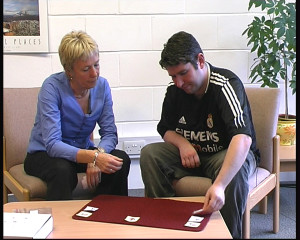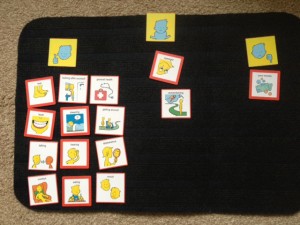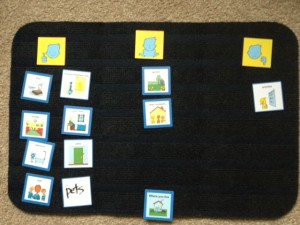The Talking Mats Team is increasingly asked to help ascertain a person’s capacity to express their views from a non-biased perspective. We are also asked to carry out service evaluations and are therefore developing independent consultancies to individuals and organisations. Our team of experienced Speech and Language Therapists, who have an in-depth knowledge of communication difficulties, are well equipped to do this.
The following are examples of independent consultancies which we have been asked to carry out:
- A lawyer asked us to work with a man who had had a severe stroke to ascertain his capacity to make decisions ranging from simple ones such as where he would like to go on holiday to complex ones such as who should control his finances. Using Talking Mats we were able to determine that he could make decisions about simple, concrete situations but wished his wife to make more complex decisions such as finances. check
- A Social Work department asked us to work with a woman with dementia and aphasia who had been sectioned. They needed to ascertain if she could understand why she could no longer live in her own home. We worked closely with her social worker and through using Talking Mats ascertained that she was unable to give informed consent.
- A Health Service facility asked us to evaluate the degree to which their patients felt involved in their care planning.
- A Care Home asked us to use Talking Mats with a 91 year old resident with dementia to find out her views about receiving dental treatment. There had been problems in the past and both the staff and her son were unsure if she understood the reasons and implications for dental treatment. Using Talking Mats, she was able to explain her thoughts about her teeth and dentures and clearly said that she was unhappy about opening her mouth for the dentist but that if her son were with her she would feel much better. We received this comment: “If you were to show the first few minutes without Talking Mats you would have thought this lovely lady lacked capacity, however the change and her engagement is noticeable.”
The following points explain with whom and how we can carry out the Talking Mats consultancy:
- Children or adults
- Family members, friends, professional staff
- Individuals or groups
- With or without a carer present
- At a venue and time which best suits the individual
- On any topic – we already have a comprehensive range of topics for both adults and children – but can create tailored symbol sets for any situation
- To find out someone’s views on a particular topic or situation at a specific point in time
- To help determine the capacity of an individual to make their own decisions
- To compare someone’s views over time
- To compare different people’s views e.g child and parent, person with dementia and carer
- We provide a detailed report with a copy of the person’s completed mat/s
To find out how we can help you and for discussion of costs please contact us at info@talkingmats.com or phone us at 01786 479511
I undertook the ‘Talking Mats’ on-line course to acquire a new skill and a way to enhance my communication with people with dementia in practice. I have found the learning strategies used are varied and interactive – so there is not a sense of sameness, even though visually there is a consistent layout to the presentation of each module (this expedites navigation). This enhances engagement and my interest so that I am never reticent in logging on to complete the next module! In the beginning, I felt that I could move a lot quicker through the course if the modules were available once each part was completed, instead of having to wait for feedback on each assignment. However, nearing the end of the training course, the benefits of this approach are now clearer. Spaced learning and spaced practice allows for thinking time and internalisation of the module components. In this way, I have come to appreciate the part skills involved in the overall process and how they come together. I now find myself observing the skills involved and the reactions of all communicating as well as the surrounding environment, body language etc. I have also found myself looking back over the past module materials to ensure I am integrating as I go and to remind myself of the rationales for the actions that need to be taken, as well as ensuring that I am more and more familiar with the new terminology that I have been exposed too.
Little did I know when I signed up that the benefits of learning about and how to use ‘Talking Mats’ would stretch wider than what I initially anticipated or wanted! In completing the course, I am now much more aware of my communication practice in general, and the part-skills involved. I can also now see the wide applicability of ‘Talking Mats’ to different populations, age groups and conditions. Communication is everywhere but it needs to be efficient and effective – I am now more confident that my communication practice will improve as a result of this course. For me this is the best outcome possible.
Please click here to find out how to book on the next course
When I went back to the Care Home where I was piloting our new Social Care symbols the staff told me this story about Ann (see previous blog). Apparently she usually is very quiet and never joins in with activities or with other residents. However when we used Talking Mats with the Activitiies symbols, she told me that she really likes singing and had started singing to me. Later that day, one of the care staff had suggested that she sing again and Ann started a song with him. Gradually other residents joined in and they had a lovely sing-song with Ann leading it!
On another day I used the Social Care symbols with Dorothy who tends to go off track and repeat stories over and over. She was quite sure about what she liked and didn’t like about the Care Home and using Talking Mats was a gentle and easy way to bring her back on topic.
I recently used the ‘Talking Mats Social Care’ pack in a Care Home with 3 residents, Ann, Barbara and Colin, who all have dementia. Neither Ann nor Barbara were wearing their glasses but all three were able to see and recognise the symbols and use Talking Mats to express their views. All three conversations took place in the lounge where the TV was on, staff were moving around and and where other residents were chatting.
Ann, whose mat is at the top of this blog, used the ‘Activities’ set and very quickly understood what to do although at times she needed to be reminded what the top scale meant. She said she was a very happy person and didn’t think I would find anything that she didn’t like but as we went through the symbols she became more thoughtful and said that she did not like DIY, exercise or knitting and sewing. She used the mid-point to indicate the things she used to enjoy but does not do now. She was delighted when she saw how positive her overall mat was.
Barbara used the ‘You’ set to tell me how she felt about herself. Although she could have placed the symbols, she preferred to sit back, tell me what she thought and let me place them for her. She felt fairly positive about most things although she was aware that her eyesight and her memory were not as good as they used to be. She also joked that she never had enough money.
Colin has dementia and is also profoundly deaf. He has only recently moved into the care home so we used the ‘Where you live’ set of symbols. Colin said several times that he didn’t think there was any point in having a conversation as he can’t hear. However after writing down the reason for doing it, he gradually realised that he could use the symbols to understand what I was asking and then express himself. He said he was generally happy with the Care Home although he missed his garden and found it hard to make friends now as he cannot hear what the other residents are saying. He also felt there are not enough activities that he can take part in. He mentioned that he has a pet dog but doesn’t know what has happened to it since he moved. One of the staff said he would try to find out. He seemed satisfied with the final mat and staff felt it would be useful to use Talking Mats more with him to reduce his isolation.
The following are thoughts from Jenni, a Psychologist who attended the Talking Mats Accredited training course.
‘Meeting with five colleagues from Sweden, England and various parts of Scotland for the accredited Talking Mats Training this month has been a fascinating experience. I have been accustomed to using Talking Mats with children and young people over the past seven years, and have seen the value of the approach in helping young people give their views for a meeting – particularly if they have communication difficulties and would struggle either through lack of confidence or skill to speak out when others are present.
However, we were not just a group who work with children and young people. Most came from health settings and examples were drawn from elderly patients, some with dementia, others with autism. As we shared our videos and told our stories it was obvious to me how relevant Talking Mats can be in those settings too. Some of the stories shook me. One person told how she was deep in conversation with a lady over her Talking Mat when the tea lady burst in, poured a cup of tea for the resident, asked if she was having a good time playing at puzzles, then left before any answer could be given. Time and again we found ourselves asking what is it about our institutions that puts routines above real communication and above proper respect for an individual.
In preparing a video to bring to the training I undertook a Talking Mat with my father, who is almost 90. It was a new kind of conversation for us both, but we were surprised – the structure allowed us to talk about what was going well and what needed a bit of an adjustment in domestic life and we both learned from the conversation. I think we will do it again!
Indeed, at one stage in the training we were asked to dream big and look at how we might want to take use of Talking Mats into new areas. I identified some good friends – one 91, one 101 and one 104 – where conversation can become rather one-sided. I am interested in the power of Talking Mats to help create a genuine dialogue when these friends are reminiscing, in other words, to help me to be not just a listener but to enter the dialogue. Having a record of the conversation will help us take the discussion further when we return to it.
As ever, the time spent with Talking Mats colleagues was refreshing, stimulating and I can’t wait to go home and try out some new ideas!’
Jenni Barr, Educational Psychologist
By Dr Norman Alm, School of Computing, University of Dundee.
Have been thinking for some years – and having dialogues with Joan Murphy – about this : would it be possible to come up with a new type of AAC where both the non-speaking person and their communication partner(s) were equally in joint control of some sort of system? Imagine a touch screen which also could be controlled by switch input. A non-speaking person and their communication partner are both engaged with the screen and both equally making use of it to do … what ?
Don’t know at the moment, but there are several suggestions for ways to explore and develop this idea further. Talking Mats is one.

The purpose is to help the person with communication difficulties express their opinions, with the other participant being a facilitator. But notice what is not happening – a face-to-face interview. Instead both participants look away from each other and focus on the mutual task, manipulating the symbols on the mat to produce the communication. Much less stressful – and much more enjoyable and productive. Another example is the CIRCA system, which supports what is usually problematic communication between a person with dementia and a carer or relative. The support takes the form of touchscreen access to an engaging multimedia display of reminiscence material drawn from public archives. Again a potentially stressful and unproductive face-to-face encounter is converted into an enjoyable mutual activity that flows effortlessly. The design of each of these systems taps into something powerfully motivating. Talking Mats lets the person describe their emotional reactions to a subject, as manifested by the scale which organises the elements on display into a snapshot of that person’s individual feelings. CIRCA makes use of the one faculty still operative even in quite advanced dementia – the ability to recall long-term memories and enjoy sharing them.
Both these systems offer a structured communication encounter in which the structure has the effect of not restricting, but freeing up the communication. Crucially ( I would argue) both free the participants from the direct responsibility of keeping the interaction going and let them share that responsibility with a third agent.
Grandma Murphy’s thoughts
Last Monday I was visiting my mum-in-law who is 95 and has severe dementia. She wasn’t great when I arrived and the staff said she was very tired. It was hard to understand what she was saying and she seemed very frail. For something to do, I showed her some of the new Talking Mats images on my iPad and she perked up and smiled at several of them.
I then took a risk and suggested she might like to use them to tell me what she thinks about herself. I was amazed as she looked carefully at each image, thought about it, made a comment and indicated where she wanted to put it on the ‘mat’. For the first time in ages with me she seemed to be in the present and not in some confused place in her mind
Here are some of her comments:
Getting around – she said she was glad she has a wheel chair to help
Hearing – she said she thought her hearing had got better ( I later discovered she had just got a new hearing aid that morning!)
Feet – sometimes her feet are sore underneath (the staff are going to get the chiropodist to have a look)
Talking – she said it depends who she’s talking to!
Money – said she could always do with more!
The 3 things she was not happy about were – needing help from others, taking her medication and her teeth. (The staff confirmed that she hates taking her medication and have referred her to the dentist).
She loved the pictures and took loads of time thinking about each one and really studied the whole mat at the end.
Her granddaughter Susan said: ‘I thought it was amazing to get a sense of what Grandma is thinking. This may be silly but I actually felt really moved by it! It’s so hard to get any sense out of Grandma these days so it was really fascinating to get an insight into her thoughts.’
The following article has just been published:
Murphy, J., & Oliver, T.M. (2013) The use of Talking Mats to support people with dementia and their carers to make decisions together. Health & Social Care in the Community Health and Social Care in the Community 21(2), 171–180
A resource which has been developed form our research is Talking Mats (bronze) Dementia and Social Care Click here
For further information please contact info@talkingmats.com This email address is being protected from spambots. You need JavaScript enabled to view it.
 Online training login
Online training login 





